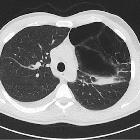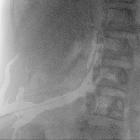Proteus-Syndrom









Proteus syndrome is a rare congenital, multisystemic, hamartomatous condition characterized by asymmetrical overgrowth of almost any part of the body and a broad spectrum of manifestations. It can affect tissue from any germinal layer. It is suspected to be a genetic condition, but a particular gene is not currently identified.
Clinical presentation
Affected patients usually appear normal at birth and progressively develop abnormalities in childhood. The progression usually stops after adolescence . The highly variable clinical manifestations frequently lead to initial misdiagnosis .
Common clinical manifestations include:
- cerebriform connective tissue nevus: virtually pathognomonic
- epidermal nevus
- disproportional overgrowth: hemihypertrophy/partial gigantism
- limbs
- vertebrae
- calvarial thickening
- rarely: external auditory meatus, viscera (spleen, kidney, thymus)
- macrodactyly
- dysregulation of adipose tissue: lipoma, regional absence of fat, overgrowth of fat in the posterior/anterior body wall or un subcutaneous fat of the extremities
- vascular malformations: capillary, venous or lymphatic
Less common findings include :
- bilateral ovarian cystadenomas
- parotid monomorphic adenoma
- abnormal facial features, e.g. dolichocephaly, low nasal bridge, anteverted nares
Radiographic features
Radiographic features are not specific and refer to any clinical characteristics. However, characteristically, Proteus syndrome is considered when there is hemimegalencephaly, extensive lymphangitic or vascular malformations and asymmetric hemihypertrophy .
Other radiographic features include enlarged and dysplastic vertebral bodies, scoliosis, cranial exostosis, osteomas, osteochondromas, enchondromas and genu valgum may also occur.
The diagnosis is either suspected on clinical grounds or with a combination of radiologic abnormalities.
Differential diagnosis
Differential diagnosis is mostly done on a clinical basis since most of the clinical manifestations are not specific. However, the differential diagnosis includes:
- Klippel-Trénaunay syndrome
- neurofibromatosis type 1
- epidermal nevus syndrome
- encephalocraniocutaneous lipomatosis
- CLOVE syndrome
- Maffucci syndrome/Ollier disease
History and etymology
The name of this syndrome comes from the Greek god of the sea Proteus who had the ability to change his shape to avoid capture, it was proposed by Wiedemann et al. in 1983. The name thus refers to the unpredictable asymmetric gigantism/hemihypertrophy associated with this disease. The first case report (1884) of this disease is credited to Sir Frederick Treves regarding his famous patient, Joseph Merrick (known as the "Elephant Man") .
Siehe auch:
- Exostose
- Neuroblastom
- Rhabdomyosarkom
- Ollier-Syndrom
- Hepatoblastom
- Beckwith-Wiedemann-Syndrom
- Maffucci-Syndrom
- Klippel-Trénaunay-Weber-Syndrom
- Neurofibromatose
- PTEN-Hamartom-Tumor-Syndrom
- Makrosomie
- Haberland-Syndrom
- Makroglossie
- lokaler Gigantismus
- Plazentamegalie
- CLOVES-Syndrom
und weiter:

 Assoziationen und Differentialdiagnosen zu Proteus-Syndrom:
Assoziationen und Differentialdiagnosen zu Proteus-Syndrom:










